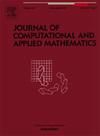HTL-WASI preconditioner for finite element discretization of complex ADR equation and its application
IF 2.1
2区 数学
Q1 MATHEMATICS, APPLIED
Journal of Computational and Applied Mathematics
Pub Date : 2025-05-04
DOI:10.1016/j.cam.2025.116726
引用次数: 0
Abstract
The convection diffusion reaction (ADR) equation is widely used in engineering applications. In this paper, we focus on a complex ADR equation arising from Helmholtz equation with impedance boundary conditions, prove the coerceiveness and boundedness of the sesquilinear functional and discuss the fast solver of the discretization. Firstly, we design a Weighted Additive Schwarz with Impedance (WASI) preconditioner, in order to overcome the dependence of the WASI preconditioner on the number of subdomains and the overlapping width, an ideal coarse space is designed. Although it can be proved that the corresponding hybrid two-level preconditioner is the exact inverse of the ADR coefficient matrix, the dimension of this coarse space is too big. In order to overcome this deficiency, a smaller dimensional coarse space was constructed by introducing local generalized eigenvalue problems (GEP) on each subdomain, and the descent rate of the corresponding two-level preconditioned GMRES method was rigorously analyzed which does not depend on mesh size, overlapping width, wave number , and the absorption parameter. Since the size of the coarse space is sensitive to and the GEP on each subdomain needs to be solved, the computational cost is too high. Therefore, we design an iterative method based on an economical two-level preconditioner, and establish a heuristic convergence theory that is supported by numerical results. Numerical experiments show the robustness of GMRES with the corresponding economical two-level preconditioner(HTLE-WASI-GMRES). Finally, for the Helmholtz finite element discretization, by using the Shifted Laplace technique and ADR equation, we design a novel fast solver combining with HTLE-WASI-GMRES for ADR equation. Numerical experiments have demonstrated the effectiveness of the algorithm.
复杂ADR方程有限元离散化的html - wasi预条件及其应用
对流扩散反应(ADR)方程在工程应用中有着广泛的应用。本文研究了一类由Helmholtz方程引起的具有阻抗边界条件的复杂ADR方程,证明了半线性泛函的强制性和有界性,并讨论了其离散化的快速求解方法。首先,设计了一个带阻抗的加权加性Schwarz (Weighted Additive Schwarz with Impedance, WASI)预调节器,克服了WASI预调节器对子域数和重叠宽度的依赖,设计了一个理想的粗糙空间;虽然可以证明对应的混合两级预条件是ADR系数矩阵的精确逆,但是这个粗糙空间的维数太大。为了克服这一缺陷,在每个子域上引入局部广义特征值问题(GEP),构造了一个更小维度的粗糙空间,并严格分析了相应的不依赖于网格大小、重叠宽度、波数k和吸收参数的两级预处理GMRES方法的下降速率。由于粗空间的大小对k很敏感,并且需要求解每个子域上的GEP,计算成本太高。因此,我们设计了一种基于经济型两级预条件的迭代方法,并建立了一个有数值结果支持的启发式收敛理论。数值实验表明,采用相应的两级经济型预调节器(HTLE-WASI-GMRES)的GMRES具有较好的鲁棒性。最后,针对Helmholtz有限元离散化问题,利用移位拉普拉斯技术和ADR方程,结合HTLE-WASI-GMRES设计了一种新的ADR方程快速求解器。数值实验证明了该算法的有效性。
本文章由计算机程序翻译,如有差异,请以英文原文为准。
求助全文
约1分钟内获得全文
求助全文
来源期刊
CiteScore
5.40
自引率
4.20%
发文量
437
审稿时长
3.0 months
期刊介绍:
The Journal of Computational and Applied Mathematics publishes original papers of high scientific value in all areas of computational and applied mathematics. The main interest of the Journal is in papers that describe and analyze new computational techniques for solving scientific or engineering problems. Also the improved analysis, including the effectiveness and applicability, of existing methods and algorithms is of importance. The computational efficiency (e.g. the convergence, stability, accuracy, ...) should be proved and illustrated by nontrivial numerical examples. Papers describing only variants of existing methods, without adding significant new computational properties are not of interest.
The audience consists of: applied mathematicians, numerical analysts, computational scientists and engineers.

 求助内容:
求助内容: 应助结果提醒方式:
应助结果提醒方式:


